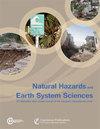利用稳健局部加权回归程序(LOWESS)分析早期余震序列快速估计地震烈度
IF 4.7
2区 地球科学
Q1 GEOSCIENCES, MULTIDISCIPLINARY
引用次数: 0
摘要
摘要破坏性地震发生后,对地震烈度进行准确和快速的评估,对于有效的早期应急反应至关重要。我们提出了一种改进的AL-SM99方法,通过分析主震后2小时内发生的余震序列来评估地震烈度。以2000 ~ 2023年全球发生的27次6.5 ~ 8.3级地震为例,说明了该方法的实施效果和应用条件。当震区内的断层系统清晰简单时,可用鲁棒的lowess拟合(局部加权回归程序)曲线估计断层破裂的位置和长度。即使在复杂的断层系统中,LOWESS结果也能反映出整体的破裂趋势,并作出可靠的破裂规模判断。当震级≥7.0,余震次数大于40次时,AL-SM99烈度评价结果更为可靠。利用传统方法获得的余震目录,可以对主震后1.5小时内的地震烈度进行稳定的评估。当余震次数足够大时,烈度评估时间可以大大缩短。有了早期可获得的余震,我们可以快速确定破裂断层面,并更好地估计地震强度。强度评估的结果为确定受灾最严重地区的程度提供了有用的指导。通过扩大地震烈度评价的数据源,充分利用了早期可获得的数据。该研究为探讨早期余震事件与断层破裂的关系提供了有价值的参考点。本文章由计算机程序翻译,如有差异,请以英文原文为准。
Rapid estimation of seismic intensities by analyzing early aftershock sequences using the robust locally weighted regression program (LOWESS)
Abstract. Accurate and rapid assessment of seismic intensity after a destructive earthquake is essential for efficient early emergency response. We proposed
an improved method, AL-SM99, to assess seismic intensity by analyzing aftershock sequences that occur within 2 h of mainshocks. The
implementation effect and application conditions of this method were illustrated using 27 earthquakes with Mw 6.5–8.3 that occurred
globally between 2000 and 2023. When the fault system in the seismic region is clear and simple, the robust LOWESS-fitted (locally weighted regression program) curves could be used to estimate the location and length of the fault rupture. LOWESS results can indicate the overall rupture trend
and make reliable rupture-scale judgments even when the fault system is complex. When Mw ≥ 7.0 and the number of aftershocks
exceeds 40, the AL-SM99 intensity evaluation results may be more reliable. Using aftershock catalogues obtained by conventional means allows for a
stable assessment of seismic intensities within 1.5 h of the mainshock. When the number of aftershocks is sufficiently large, the intensity assessment time can be greatly reduced. With early accessible aftershocks, we can quickly determine the rupture fault planes and have a better estimate of the seismic intensities. The results of the intensity assessment provide a useful guide for determining the extent of the hardest-hit areas. By expanding the data sources for seismic intensity assessment, the early accessible data are utilized adequately. This study provides a valuable reference point for investigating the relationship between early aftershock events and fault rupture.
求助全文
通过发布文献求助,成功后即可免费获取论文全文。
去求助
来源期刊
CiteScore
7.60
自引率
6.50%
发文量
192
审稿时长
3.8 months
期刊介绍:
Natural Hazards and Earth System Sciences (NHESS) is an interdisciplinary and international journal dedicated to the public discussion and open-access publication of high-quality studies and original research on natural hazards and their consequences. Embracing a holistic Earth system science approach, NHESS serves a wide and diverse community of research scientists, practitioners, and decision makers concerned with detection of natural hazards, monitoring and modelling, vulnerability and risk assessment, and the design and implementation of mitigation and adaptation strategies, including economical, societal, and educational aspects.

 求助内容:
求助内容: 应助结果提醒方式:
应助结果提醒方式:


